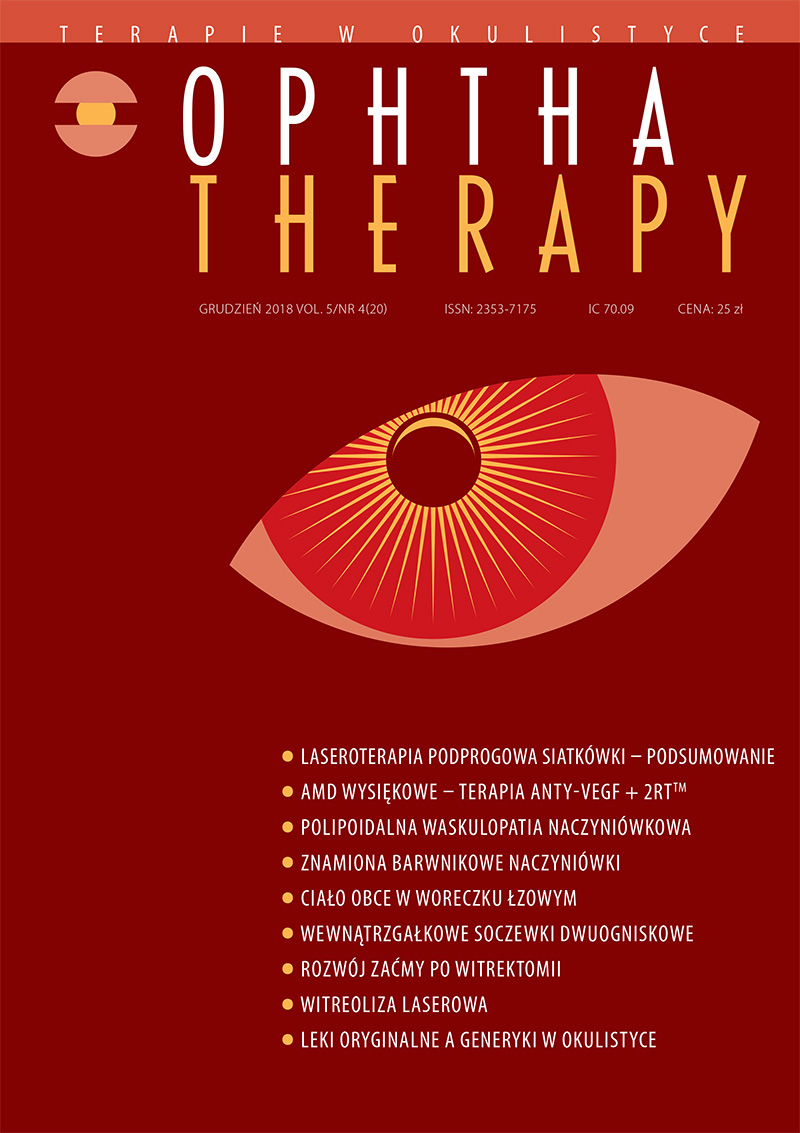Bifocal toric intraocular lenses – 6 years of own experience
Main Article Content
Abstract
A retrospective analysis of parameters of vision and postoperative complaints in 428 patients (606 eyes) undergoing cataract surgery or clear lens extraction with ontime bifocal lens implantation from Oculentis®. An artificial lens implantation has been used in one or in both eyes in patients without preoperative eye defect. Next groups have included patients with preoperative hyperopia, myopia and with corneal astigmatism. The biggest number of patients have got spherical lenses with addition +3,0 Dsph to near distances, subsequently with addition +1,5 Dsph and toric lenses. Another two groups who were analyzed were whose patients who needed posterior vitrectomy and who have been preoperatively diagnosed with Age Related Macular Changes, dry and exudative changes. The main inclusion criteria was a need to become free of glasses to far and near distances. Almost all of patients have gained satisfactory visual acuity and quality of vision while maintaining the appropriate inclusion criteria. One of the criteria assumes that patients with bigger size of the pupil have implanted lenses with less addition to near distances and corneal astigmatism was corrected even if the value was below 1 dioptria.
Downloads
Article Details

This work is licensed under a Creative Commons Attribution-NonCommercial-NoDerivatives 4.0 International License.
Copyright: © Medical Education sp. z o.o. License allowing third parties to copy and redistribute the material in any medium or format and to remix, transform, and build upon the material, provided the original work is properly cited and states its license.
Address reprint requests to: Medical Education, Marcin Kuźma (marcin.kuzma@mededu.pl)
References
2. Zvorničanin J, Zvorničanin EJ. Premium intraocular lenses: The past, present and future. Curr Ophthalmol. 2018; 30(4): 287-96.
3. Piovella M, Colonval S, Kapp A et al. Patient outcomes following implantation with a trifocal toric IOL: twelve month prospective multicentre study. Eye (Lond). 2018 Sep 6.
4. Mojzis P, Kukuckova L, Majerova K et al. Postoperative visual performance with a bifocal and trifocal diffractive intraocular lens during a 1-year follow-up. Int J Ophthalmol. 2017; 10(10): 1528-33.
5. Ferreira TB, Marques EF, Rodrigues A et al. Visual and optical outcomes of a diffractive multifocal toric intraocular lens. J Cataract Refract Surg. 2013; 39(7): 1029-35.
6. Nowe standardy kwalifikacji do zabiegów usunięcia zaćmy. Online: www.nfz.gov.pl/aktualnosci/aktualnoscicentrali/nowe-standardy-kwalifikacji-do-zabiegow-usuniecia-zacmy,7176.html.
7. Kretz FTA, Tarib I, Teisch S et al. Clinical Evaluation of a Novel Intraocular Lens with Enhanced Depth of Focus (EDOF) to Increase Visual Acuity for Intermediate Distances. Klin Monbl Augenheilkd. 2018; 235(8): 874-80.
8. Black S. A clinical assessment of visual performance of combining the TECNIS® Symfony Extended Range of Vision IOL (ZXR00) with the +3.25 D TECNIS Multifocal 1-piece IOL (ZLB00) in subjects undergoing bilateral cataract extraction. Clin Ophthalmol. 2018; 12: 2129-36.
9. Abou Samra W, Mokbel T, Elwan M et al. Two-stage procedure in the management of selected cases of keratoconus: clear lens extraction with aspherical IOL implantation followed by WFG-PRK. Int J Ophthalmol. 2018; 11(11): 1761-7.
10. Camps VJ, Miret JJ, García C et al. Simulation of the Effect of Different Presbyopia-Correcting Intraocular Lenses With Eyes With Previous Laser Refractive Surgery. J Refract Surg. 2018; 34(4): 22227.
11. Albarrán-Diego C, Muñoz G, Rohrweck S et al. Validity of automated refraction after segmented refractive multifocal intraocular lens implantation. Int J Ophthalmol. 2017; 10(11): 1728-33.
12. Yildirim TM, Auffarth GU, Tandogan T et al. In Vitro Evaluation of the Optical Quality of Segmental Refractive Multifocal Intraocular Lenses. Klin Monbl Augenheilkd. 2017 Nov 8.
13. Feng K, Guo HK, Zhang YL et al. Visual quality comparison after multifocal toric intraocular lens or monofocal toric intraocular lens implantation. Zhonghua Yan Ke Za Zhi. 2017; 53(4): 274-80.
14. Wang SY, Stem MS, Oren G et al. Patient-centered and visual quality outcomes of premium cataract surgery: a systematic review. Eur J Ophthalmol. 2017; 27(4): 387-401.
15. Ton Van C, Tran THC. Incidence of posterior capsular opacification requiring Nd:YAG capsulotomy after cataract surgery and implantation of enVista® MX60 IOL. J Fr Ophtalmol. 2018; 41(10): 899-903.
16. Marques EF, Ferreira TB, Simões P. Visual Performance and Rotational Stability of a Multifocal Toric Intraocular Lens. J Refract Surg. 2016; 32(7): 444-50.
17. Cavallini GM, Volante V, Campi L et al. Postoperative diffuse opacification of a hydrophilic acrylic intraocular lens: analysis of an explant. Int Ophthalmol. 2018; 38(4): 1733-9.
18. Holladay JT. Quality of Vision 2007: 3-9.
19. Piracha AR. Using angle alpha in premium IOL screening. Cataract & Refractive Surgery Today. 2016: 24-25.
20. Sobolewski P. Wpływ aberracji na widzenie po zabiegu korekcji laserowej. Okulistyka po Dyplomie. 2017; 4.
21. Park CY, Oh SY, Chuck RS. Measurement of angle kappa and centration in refractive surgery. Curr Opin Ophthalmol. 2012; 4: 269-75.

